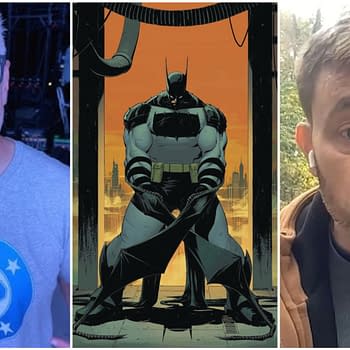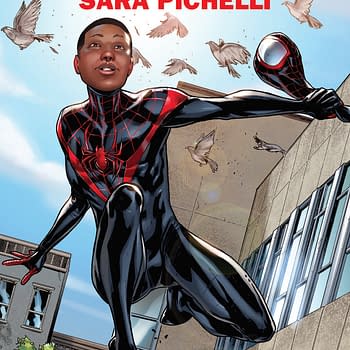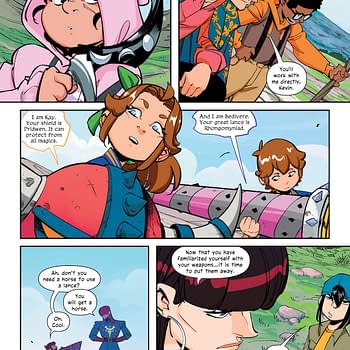Posted in: Comics | Tagged: Beatrice Is Dead, clint eastwood, Freddy Krueger, kickstarter, Mad Magazine, S Zainab WIlliam
Bend It Like Beatrice: On Bending The Horror Genre
S. Zainab Williams writes for Bleeding Cool:
While the only comics I grew up with were Mad magazine, Calvin and Hobbes, the toilet paper commonly known as the Sunday comics, and–here I pause to take cover from tomatoes, jeers, and stray bullets–Archie Comics, I lived on horror. I squealed with innocent glee when I heard the creak of a gate and then the low moan of an organ–my cue to run into the living room for Tales from the Crypt. I imagined Freddy Krueger was talking directly to me during the intros to Freddy's Nightmares. As an adult, before writing and Kickstarter swallowed all of my free time, I spent most Friday nights curled up with a cocktail strong enough to strip the petrified lining of Clint Eastwood's stomach, indulging in a bottomless well of terrible, wonderful Netflix horror. Horror is my sacred cow. So I took a cleaver to it.
I didn't intend to break tradition with the horror genre when I started writing Beatrice is Dead. I didn't even intend to write a horror graphic novel. This unusual coming of age story set in the afterlife began as a form of therapy. I birthed it while suffering from what the poetic call ennui and what I call depression. It was the kind of depression that pulls a disappearing trick on large swaths of one's life. Beatrice is Dead began as a few chapters of a young adult novel. I abandoned the story when my depression worsened and I could barely get myself out of bed, much less to a pen. I took a break from college to get better, and I did get better. Beatrice was forgotten.
About eight years later, a couple of artistic friends, both of whom were illustrating comics, convinced me to try my hand at comic writing. As I said, I had a meager knowledge of comics. I'd always been surrounded by comic book nerds, always dated and befriended them because I was a socially inept bookworm and fantasy geek. I understood the sentiment. Still, being friends with comic nerds didn't mean I could write a comic. I worried that I had no place in that world. What the hell did I know? Oh, and what did a comic script look like?
As they tend to do, my fears stoked a fire somewhere around the vicinity of my backside. I couldn't stop thinking about this idea, so I talked it out again with Robert Burrows, one of said artistic friends, who had just finished illustrating horror comic Something Animal. I was a fan of Rob's dark, gritty style and his fearless approach to horror art. I found myself convincing him to work on a graphic novel with me. I wanted to write something that lent to his strengths as an artist so he would want to work long hours to produce something we could both be proud of. I thought about his style and noted our mutual interest in Clive Barker, particularly Hellraiser. I remembered Beatrice.
I banged out a draft of City of Ash, the first volume of the graphic novel, in a few days. City of Ash is an introduction to introspective teen Beatrice ("Beat") Robinson. It follows her into the eerie, brindled world of the dead after, unable to bear the psychological consequences of trauma, she commits suicide. I dredged up what I could of my own painful, bleak past. I gathered my worst nightmares–the things that keep me up at night and make me turn off the news. I sifted through humanity's worst traits. I thought about my own journey toward recovery and the long struggle to get somewhere else. And I remembered the worst things about being depressed: the guilt and self-loathing, the isolation, my inability to communicate well enough to get help, and other people's inability or unwillingness to listen. This was going to be an ugly story, but one I needed to tell. It would be hard to look at. It would be pure horror.
It was in creating pure horror and in writing short stories about the final hours of the side characters that the graphic novel took on a life of its own. It stopped being about genre and started being about voices. These voices decided their genre. I found myself writing mainstream fiction for one character and stream of consciousness to the tune of backwoods grotesquery the next. By sectioning the comic proper with these stories, we created a book that was at once cohesive and at odds. The stories freed me of genre. They changed the way I looked at the characters and blurred the line between good and evil. Writing the "Final Hours" flash fiction and the story of Beat shifted my definition of horror.
Horror doesn't live in one genre. We can find it in literature, fairy tales, reality. Sometimes it concedes to a happy ending and we forget we ever encountered it; sometimes it sticks around, staining everything so that we forget what it means to be out of its company. And horror isn't always what it seems.
I don't yet know how horror will end Beat's story, but I'm bound to her and her journey. I expect to continue to be surprised by what I discover along the way.
If you're interested in Beat's story and want to take the journey with her, please consider backing City of Ash over at Kickstarter. If we reach the $4,000 mark by midnight, September 17, we'll post one of the "Final Hours" stories for a limited-time free reading (and maybe I'll throw an outtakes reel from the Kickstarter video on the Beatrice is Dead Facebook page so you can see why writers and artists should never be asked to get in front of a camera and talk).


















